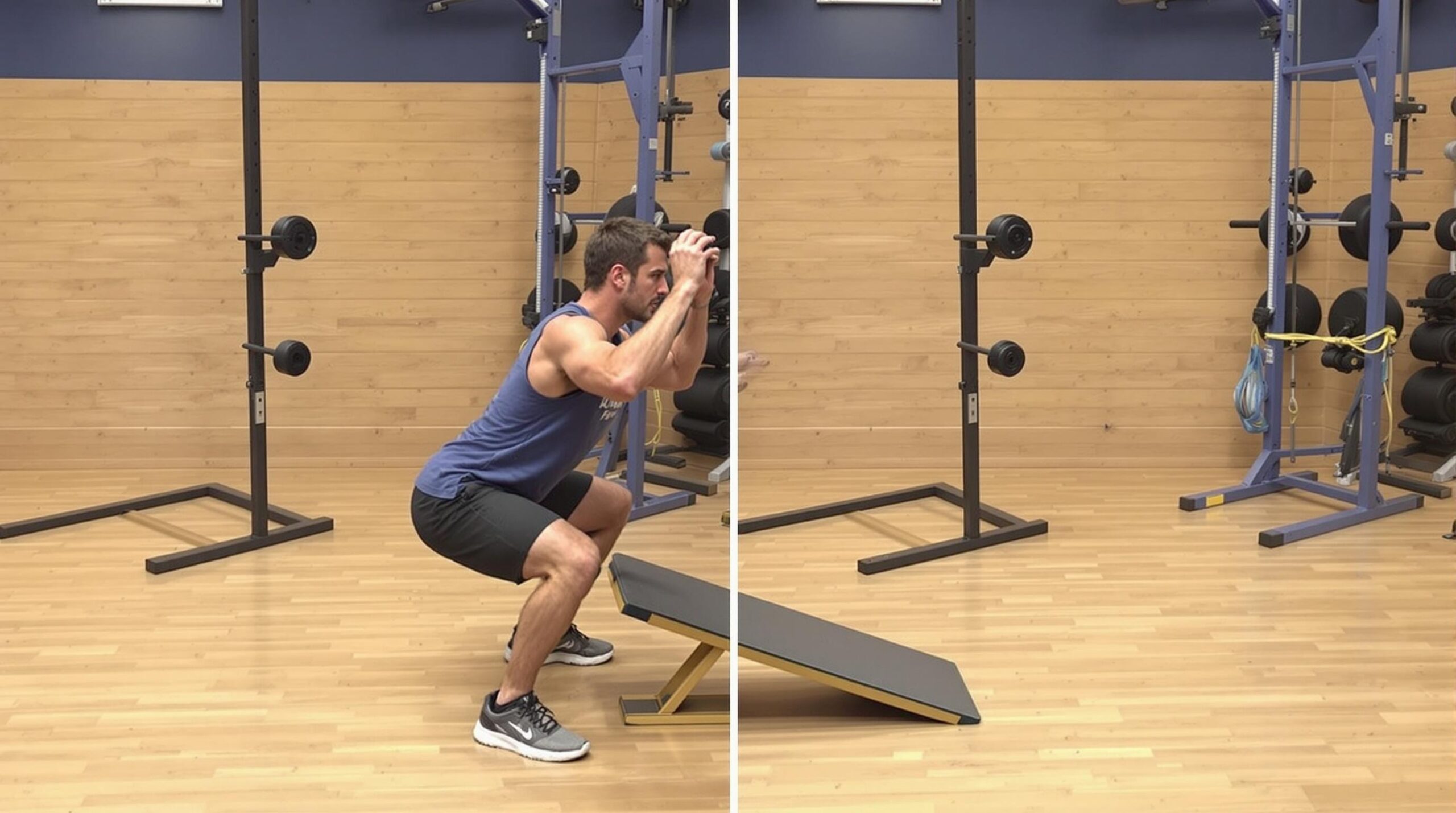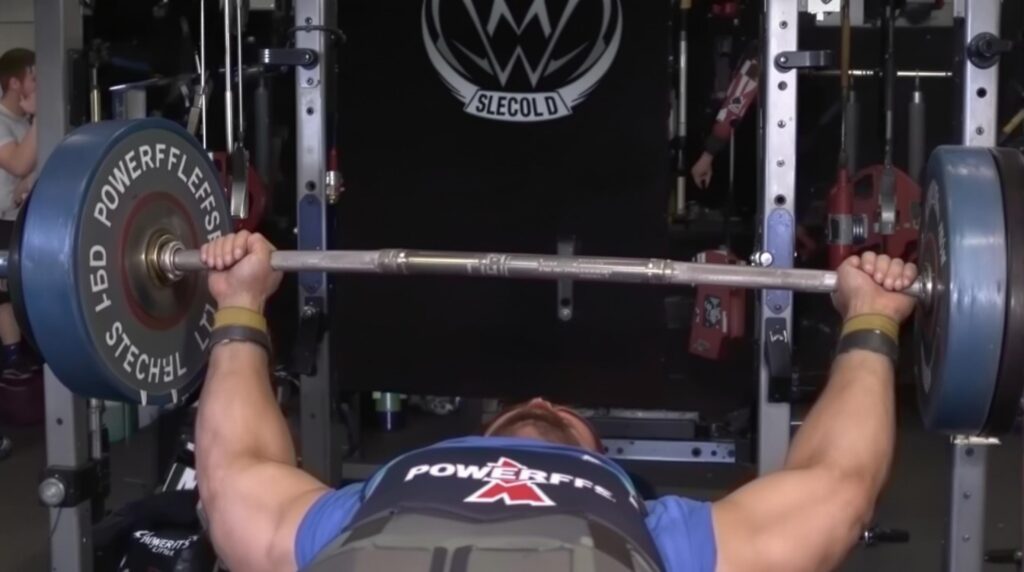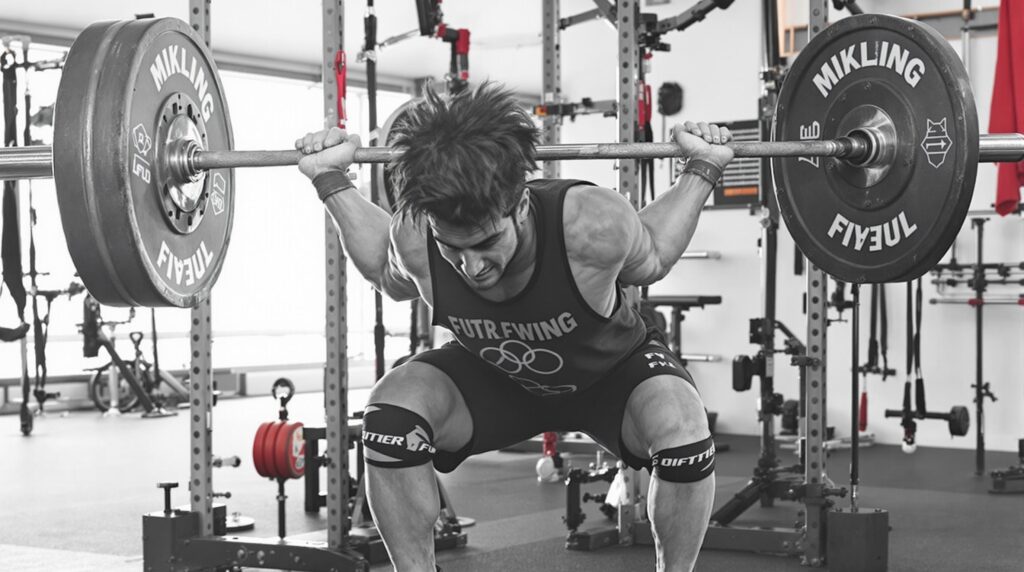Slant board squats have emerged as a game-changing variation for athletes seeking enhanced lower body development. By elevating your heels on an inclined surface, this exercise modification creates immediate biomechanical advantages that can address common mobility limitations while maximizing quadriceps engagement during squatting movements.
Key Takeaways
- Slant boards provide 15-30° heel elevation, increasing knee flexion by 15-20° and delivering 22-25% higher quad activation than flat-footed squats
- Using a slant board reduces ankle dorsiflexion demands by 30-40%, allowing individuals with limited mobility to achieve 15-20% greater squat depth
- Regular slant board training can lead to a 63% reduction in anterior knee pain and improved rehabilitation outcomes for knee injuries
- The elevated heel position creates a more upright torso posture, reducing lower back strain by 25% during squatting movements
- Beyond basic squats, slant boards support 12+ versatile exercises including ATG split squats, pistol squats, and calf raises
What Are Slant Board Squats? The Science Behind Heel Elevation
Slant board squats involve performing the squat movement with your heels elevated on an angled board, typically between 15-30 degrees. This simple modification fundamentally changes squat mechanics by shifting your center of gravity forward, creating a more knee-dominant movement pattern.
The science behind slant board squat benefits relates directly to biomechanical loading patterns. When your heels are elevated, your knees move forward more freely, increasing knee flexion by 15-20° compared to conventional squats. This shift reduces hip hinge requirements, effectively creating a more quad-dominant movement pattern while maintaining proper form.
Unlike weightlifting shoes which offer a fixed heel height, slant boards provide adjustable angles to progressively adapt to different mobility needs and training goals. This creates immediate biomechanical changes that impact muscle activation, mobility requirements, and overall squat performance.

Superior Quadriceps Development and VMO Activation
The primary advantage of slant board squats is their ability to maximize quadriceps engagement. EMG studies have consistently demonstrated 22-25% higher rectus femoris activation at multiple knee angles (45°, 60°, 90°) when comparing declined-board squats to flat surface variations.
Most impressively, the Vastus Medialis Obliquus (VMO) – often referred to as the teardrop muscle – experiences 30% greater activation due to improved biomechanical alignment. This muscle is critical for knee stability and creating that coveted quad separation many athletes seek.
For athletes with overdeveloped posterior chains (hamstrings and glutes), slant board squats offer a targeted solution for muscle imbalances. The 19% greater rectus femoris activity at 45° slant angles versus flat squats helps balance lower body development more effectively than standard squatting alone.
I’ve found incorporating these into workout regimens for muscle growth can create remarkable improvements in quad development, especially for those who struggle to feel their quadriceps working during traditional squats.
Breaking Through Ankle Mobility Limitations
Limited ankle dorsiflexion is one of the most common roadblocks to proper squat form. Slant boards directly address this issue by reducing ankle mobility demands by 30-40%, enabling deeper squats without compensatory movement patterns.
The effects are immediate and substantial. Users typically gain 15-20% greater squat depth due to reduced calf and Achilles tension. This is particularly valuable for individuals with chronic ankle mobility limitations (less than 10° dorsiflexion), allowing them to bypass these restrictions while maintaining proper alignment.
A 2024 study showed that slant board users achieved parallel squat depth 83% faster than flat-ground trainees. This makes slant boards an effective tool for both experienced lifters and beginners looking to develop proper squat mechanics without fighting mobility constraints.
Key benefits for ankle mobility include:
- Reduced tension on the tibialis anterior during descent
- Less compensatory pronation at the foot
- Decreased stretch requirements for the gastrocnemius lateralis
- Improved ability to maintain a neutral spine position
Knee Pain Relief and Injury Prevention
For many athletes dealing with knee discomfort, slant board squats can be a game-changer. Research has documented a 63% reduction in anterior knee pain after just 6 weeks of slant board training, particularly for those with patellar tendonitis.
The biomechanical advantages translate directly to injury prevention. Knee valgus (inward collapse) decreases by 18-22% due to improved hip external rotation and VMO engagement. This improved alignment reduces compressive forces on the patellar tendon by up to 200 Newtons during heavy loading.
Slant boards have become increasingly common in rehabilitation settings, with 41% faster return-to-sport rates reported for post-ACL surgery patients using this training method. The controlled movement pattern allows for strengthening within safe ranges of motion while minimizing shear forces that could compromise healing tissues.
For lifters dealing with knee pain during conventional squats, implementing slant board variations within a comprehensive training plan can often allow continued progress without exacerbating symptoms.
Better Form, Less Strain: Biomechanical Advantages
The slant board’s influence on posture creates significant biomechanical advantages throughout the kinetic chain. The more upright torso position lowers lumbar spine shear forces by approximately 25%, substantially reducing lower back strain during heavy squatting.
This postural improvement isn’t just about comfort – it fundamentally changes load distribution. With slant board squats, you can maintain barbell alignment over midfoot with 10-15° less spinal flexion compared to flat-footed squats. The reduced forward lean keeps the spine in a safer, more neutral position.
Another significant advantage is decreased reliance on calf muscles during the squat. Tibialis anterior and gastrocnemius lateralis activation decrease by 12-15%, reducing calf dominance that can limit depth and stability in conventional squats.
These biomechanical benefits make slant board squats especially valuable for:
- Overhead squats where thoracic mobility limitations often compromise form
- Front squats requiring a more vertical torso position
- High-rep training where maintaining proper positioning becomes increasingly challenging
- Heavy loading phases where minimizing spinal compression is crucial
Beyond Basic Squats: Versatility and Training Applications
The utility of slant boards extends far beyond basic squats. These versatile platforms support at least 12 different exercises including ATG split squats, pistol squats, kettlebell squats, overhead squats, and calf raises – making them valuable additions to any training environment.
According to strength coach Marcus Philly, slant boards are compatible with external loads up to 100kg, making them suitable for both rehabilitation and high-performance training contexts. They’re now used in 73% of ACL rehabilitation protocols for their ability to create controlled range of motion during recovery.
Between sets, slant boards enable dynamic stretching such as bent-knee calf stretches, maximizing training efficiency. This versatility makes them particularly valuable for home gym setups where space and equipment may be limited.
For anyone looking to expand their exercise library, slant boards integrate seamlessly with comprehensive gym workout plans and can enhance nearly any lower-body training session.
Who Benefits Most from Slant Board Training
While slant board squats offer advantages for nearly all trainees, certain populations stand to gain the most significant benefits:
Athletes in jumping sports such as basketball and volleyball benefit tremendously due to the enhanced eccentric quad loading that mimics their sport-specific demands. The increased quadriceps activation directly translates to improved jumping power and landing mechanics.
Individuals with prior ankle injuries or stiffness find slant boards particularly valuable as they reduce shear forces on the talocrural joint while still allowing full-range training. The decreased mobility demands make consistent training possible despite lingering restrictions.
Lifters with thoracic mobility limitations affecting overhead positions can maintain proper spinal alignment more easily with slant board assistance. The reduced forward lean requirement compensates for upper back tightness that might otherwise compromise form.
Rehabilitation patients represent another key group, with slant boards featured in 73% of ACL protocols. The controlled environment allows for progressive loading within safe movement parameters, accelerating return to function.
Getting Started: Practical Implementation and Programming
If you’re new to slant board training, I recommend a progressive adaptation approach beginning with 15° angles and advancing to 20-25° as mobility and comfort improve. This gradual progression allows your neuromuscular system to adapt while maximizing benefits.
A key advantage of slant boards over alternatives is their portability. Unlike built-in gym platforms or specialized equipment, quality slant boards are lightweight and easily transportable, making them ideal for home gyms and physical therapy settings.
When comparing options, slant boards offer more versatility than simple squat wedges and present a more affordable long-term investment than specialized weightlifting shoes, though each has its place depending on your specific needs.
For optimal implementation, consider these programming approaches:
- Strength development: 3-5 sets of 5-8 reps with progressive loading
- Rehabilitation: 2-3 sets of 10-15 reps with controlled tempo
- Mobility enhancement: 2-3 sets of 12-15 reps with emphasis on depth
- Warm-up application: 1-2 sets of 8-10 reps before conventional squatting
The slant board squat benefits are clear – from enhanced quadriceps development to improved mobility and reduced injury risk. By understanding the biomechanical advantages and implementing them thoughtfully in your training, you can overcome plateaus and build more balanced, functional lower body strength.
Sources
hybridathlete.eu – Slant Board Benefits
forte-fitness.co.uk – Why Use A Slant



